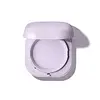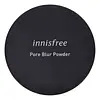What's inside
What's inside
 Key Ingredients
Key Ingredients

 Benefits
Benefits

 Concerns
Concerns

 Ingredients Side-by-side
Ingredients Side-by-side

Silica
AbrasiveDimethicone/Vinyl Dimethicone Crosspolymer
Skin ConditioningCaprylic/Capric Triglyceride
MaskingMica
Cosmetic ColorantMethicone
EmollientCI 77891
Cosmetic ColorantCI 77742
Cosmetic ColorantEthylhexylglycerin
Skin ConditioningNephrite Powder
AbrasiveDimethicone
EmollientGlyceryl Caprylate
EmollientButylene Glycol
HumectantWater
Skin ConditioningLactic Acid/Glycolic Acid Copolymer
Skin ConditioningKaolin
AbrasiveGlycerin
HumectantHydrolyzed Hyaluronic Acid
HumectantTin Oxide
AbrasiveMalpighia Glabra Fruit Extract
Skin ConditioningPropanediol
SolventHydrolyzed Corn Starch
HumectantPinus Densiflora Leaf Extract
AntimicrobialPolyquaternium-10
Saururus Chinensis Extract
Skin ConditioningEuterpe Oleracea Fruit Extract
1,2-Hexanediol
Skin ConditioningMother Of Pearl
AbrasiveHedychium Coronarium Root Extract
MaskingTocopherol
AntioxidantSodium Magnesium Silicate
Disodium EDTA
Sodium Benzoate
MaskingLactic Acid
BufferingPotassium Sorbate
PreservativeGlutathione
Diamond Powder
AbrasiveXanthan Gum
EmulsifyingSilica, Dimethicone/Vinyl Dimethicone Crosspolymer, Caprylic/Capric Triglyceride, Mica, Methicone, CI 77891, CI 77742, Ethylhexylglycerin, Nephrite Powder, Dimethicone, Glyceryl Caprylate, Butylene Glycol, Water, Lactic Acid/Glycolic Acid Copolymer, Kaolin, Glycerin, Hydrolyzed Hyaluronic Acid, Tin Oxide, Malpighia Glabra Fruit Extract, Propanediol, Hydrolyzed Corn Starch, Pinus Densiflora Leaf Extract, Polyquaternium-10, Saururus Chinensis Extract, Euterpe Oleracea Fruit Extract, 1,2-Hexanediol, Mother Of Pearl, Hedychium Coronarium Root Extract, Tocopherol, Sodium Magnesium Silicate, Disodium EDTA, Sodium Benzoate, Lactic Acid, Potassium Sorbate, Glutathione, Diamond Powder, Xanthan Gum
 Reviews
Reviews

Ingredients Explained
These ingredients are found in both products.
Ingredients higher up in an ingredient list are typically present in a larger amount.
Ethylhexylglycerin (we can't pronounce this either) is commonly used as a preservative and skin softener. It is derived from glyceryl.
You might see Ethylhexylglycerin often paired with other preservatives such as phenoxyethanol. Ethylhexylglycerin has been found to increase the effectiveness of these other preservatives.
Glyceryl Caprylate comes from glycerin and caprylic acid, a fatty acid from coconut. It has emollient and emulsifier properties.
As an emollient, it helps hydrate your skin. Emollients work by creating a barrier on your skin to trap moisture in, helping to keep your skin soft and smooth.
On the other hand, emulsifiers prevent ingredients (such as oil and water) from separating.
Learn more about Glyceryl CaprylateSilica, also known as silicon dioxide, is a naturally occurring mineral. It is used as a fine, spherical, and porous powder in cosmetics.
Though it has exfoliant properties, the function of silica varies depending on the product.
The unique structure of silica enhances the spreadability and adds smoothness, making it a great texture enhancer.
It is also used as an active carrier, emulsifier, and mattifier due to its ability to absorb excess oil.
In some products, tiny microneedles called spicules are made from silica or hydrolyzed sponge. When you rub them in, they lightly polish away dead skin layers and enhance the penetration of active ingredients.
Learn more about SilicaTocopherol (also known as Vitamin E) is a common antioxidant used to help protect the skin from free-radicals and strengthen the skin barrier. It's also fat soluble - this means our skin is great at absorbing it.
Vitamin E also helps keep your natural skin lipids healthy. Your lipid skin barrier naturally consists of lipids, ceramides, and fatty acids. Vitamin E offers extra protection for your skin’s lipid barrier, keeping your skin healthy and nourished.
Another benefit is a bit of UV protection. Vitamin E helps reduce the damage caused by UVB rays. (It should not replace your sunscreen). Combining it with Vitamin C can decrease sunburned cells and hyperpigmentation after UV exposure.
You might have noticed Vitamin E + C often paired together. This is because it is great at stabilizing Vitamin C. Using the two together helps increase the effectiveness of both ingredients.
There are often claims that Vitamin E can reduce/prevent scarring, but these claims haven't been confirmed by scientific research.
Learn more about Tocopherol